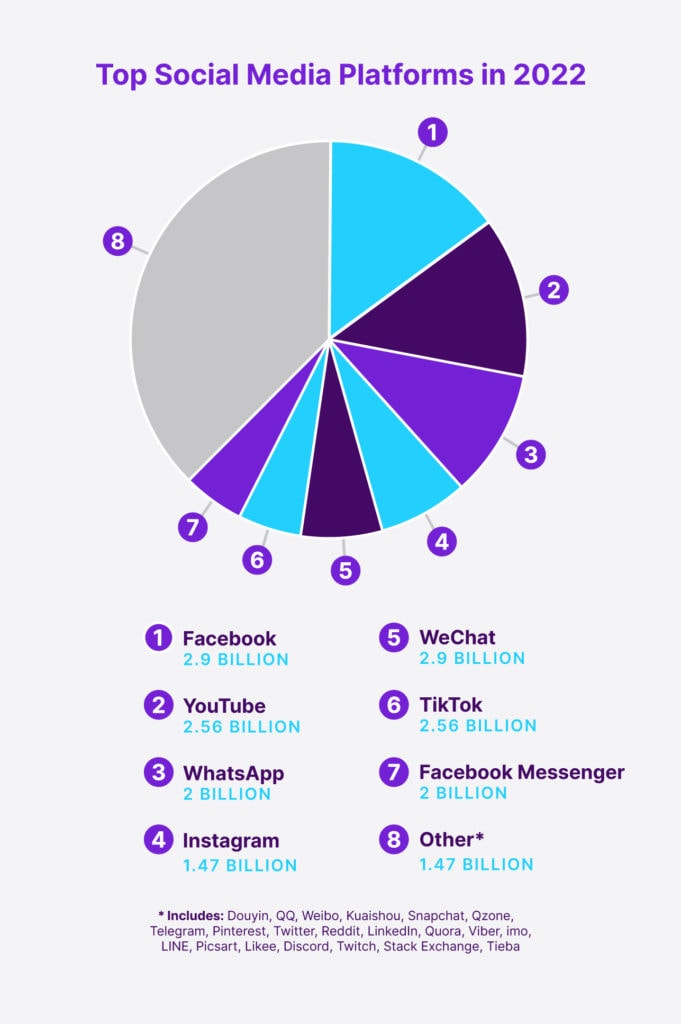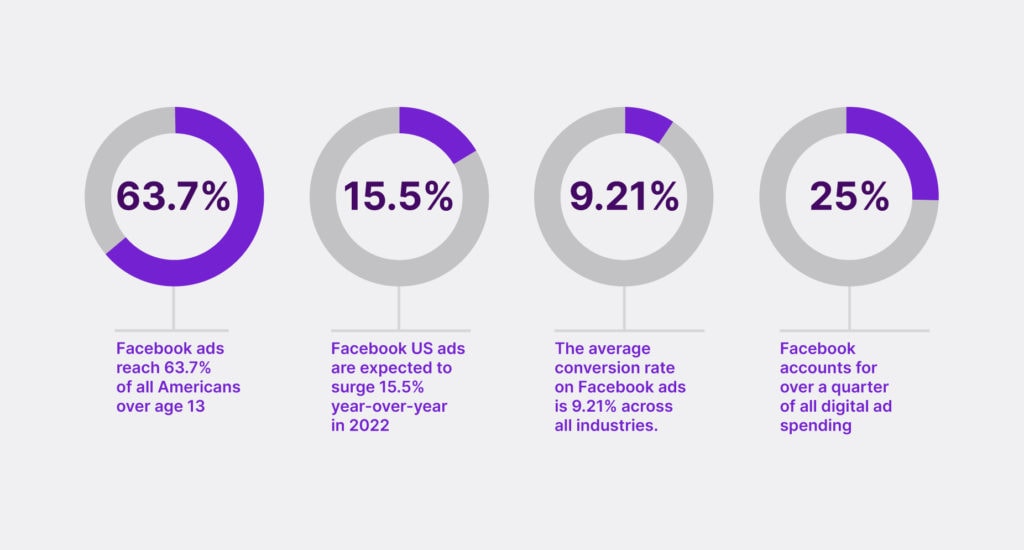What's in this article?
With nearly 3 billion users, there’s never been a better time for your mortgage business to set up shop on Facebook.
It doesn’t matter if you’re a loan officer, mortgage broker, or marketing professional for a lender, you can use the world’s largest social media platform to reach your audience.
Of course, there’s a big difference between using Facebook and generating leads on Facebook.
A defined, comprehensive strategy is critical to your success and that’s exactly what I’m going to share with you. Keep reading to learn how to generate mortgage leads with Facebook.
How do I get mortgage leads on Facebook?
It takes time, money, and manpower to generate mortgage leads with Facebook. And it starts with a landing page.
Setting up your Facebook business page is important but the first step is actually setting up where you want your followers to land.
It’s important that you send this traffic to a relevant, updated, and optimized landing page. Neglecting to do so will drag down your conversion rate, which does the same to your return on investment (ROI).
Just as your website has landing pages for each loan type, consider creating them for each traffic source, too. This can include Facebook and Twitter among other external sources.
Some basic tips for creating or improving your Facebook-specific landing page:
- Include a hard-hitting hook above the fold
- Use calls to action (CTA) throughout the landing page
- Use videos and pictures to tell your story
Along with the above, A/B split testing your landing pages is the best way to determine what’s working, what’s not, and the types of changes you can make to boost conversion rates.
Finally, Facebook as a platform provides you with several ways to ensure that you’re targeting the right audience and driving the right people to your landing page.
- Demographic targeting: Choose your audience based on age, education, gender, job title, and more.
- Interest targeting: Target users based on their assumed interests.
- Custom audiences: An option for finding and targeting your existing audience — people who are already familiar with your business — through sources such as customer lists and website traffic.
Publish organic mortgage content on Facebook
There’s more than one way to generate mortgage leads with Facebook, and it’s often best to get started by publishing organic content.
Yes, Facebook Ads are powerful but don’t get ahead of yourself. Starting with the creation of organic content allows you to:
- Familiarize yourself with the Facebook platform
- Pinpoint the type of content that does and doesn’t resonate with your audience
- Answer key questions regarding your strategy
With organic content, there’s no risk of losing money. Publish, keep an eye on performance metrics, and then try again.
Once you’ve done this for several weeks, you can then narrow your focus to publish content that closely matches what your audience is seeking.
Let’s look at three types of content to create and share on Facebook.
1. Industry news
Are mortgage rates on the rise? Is the home market booming? Are new regulations changing the way homebuyers shop for a mortgage?
If it’s worthy of being shared by others — such as major news outlets — it’s likely to intrigue your audience.
It’s easy to share someone else’s article, but it’s even easier to write up your own blog or cut a short video on your phone on the subject. Post it to your website and then share it on your page so followers can engage with it and visit your site.
2. Personal opinion
As a mortgage professional, you have plenty of knowledge to share with your audience. Don’t be shy about forming an opinion on a topic and sharing it on Facebook.
There will be people who agree and disagree with you. That’s okay. Your goal is to share insightful content that engages your audience. And more post engagement means that more people will see it in their feeds.
3. How-to
There’s no shortage of subject matter to choose from within this category.
Ideas include how to:
- Apply for a loan
- Refinance your current mortgage
- Set a home-buying budget
- Secure a low mortgage interest rate
- Compare mortgage types
This type of content establishes you as a thought leader in the mortgage space. Again, this can be written, filmed, made into an infographic, etc.—whatever resonates with your followers.
Is Facebook advertising really worth it?
Facebook advertising is one of our favorite topics. We truly believe that the right strategy can generate massive results for mortgage companies.

According to Facebook, 1.6 billion people worldwide are connected to a small business on its platform. And if that’s not enough to get you excited, Facebook ads reach 63.7% of all Americans over age 13.
In other words, the audience is there. That’s not your concern. Your focus should be fully on your approach.
Getting serious about mortgage Facebook Ads means knowing the steps to take to get up and running. The following are the seven simple steps you need to get started with Facebook Ads.
1. Choose an objective
Step one starts with an important question: What’s the most important outcome for the ad?
Facebook breaks this down into three categories:
- Awareness: Brand awareness and Reach
- Consideration: Traffic, engagement, app installs, video views, lead generation, and messages
- Conversion: Website conversions, contact information collected
Your objective can and probably will vary from ad to ad. For example, your first ad may be focused on growing your personal brand or company’s brand. Once you’ve accomplished this goal, your focus can turn to drive and converting traffic into leads.
2. Select your audience
A Facebook Ad is only as good as the audience that views it. Do you know the average age of your ideal customer? How about their location?
Choose the demographics that best represent the audience you want to reach. You could do everything else correctly, but if you choose the wrong audience you won’t have much—if any—success.
Start with age, education, gender, job title, and location. Use these filters alone or together to reach your target audience. For example, your data may show that the majority of past customers are 25 to 40-year-old males with a bachelor’s degree (or higher). Forget about all others and target this audience to start. You already know that this group is interested in what you can do for them.
3. Decide where to run your ad
You have several options including Facebook, Facebook Messenger, Audience Network, and Instagram.
If you don’t know what’s best, start by running a small experiment with each type. If easier, you can choose to run your ad across all categories. This allows you to compare apples to apples in regard to what’s performing best.
4. Set a budget
A positive ROI is the only thing that matters with Facebook advertising. You want to generate more money than you’re spending. As long as you’re doing this, your advertising campaign is profitable.
Set your daily or lifetime budget along with the time period you want your ads to run. This allows you to set a maximum, which eliminates the risk of spending more money than you’re comfortable with.
5. Pick a format
Facebook allows you to choose from multiple ad formats. These are specifically designed to work seamlessly on every device, regardless of connection speed. Your options include:
- Photo
- Video
- Stories
- Messenger
- Carousel
- Collection
- Playables
- Slideshow
Don’t get hung up on one type of format. Just as you should A/B test your messaging, do the same with your ad formats.
6. Make it live
This is when the real fun begins. Place your order, receive approval, and watch your ad go live. Keep in mind that Facebook uses an auction system with the company describing it as such:
We use an ad auction to determine the best ad to show to a person at a given point in time. The winning ad maximizes value for both people and businesses. Understanding the ad auction can help you understand your ad performance.
You may need to adjust your budget or ad radius to maximize views.
7. Measure the impact of your ad
Once your ad is running, track its performance in the Ads Manager. You can see:
- Which ads are performing best (and worst)
- If your ad is being shared efficiently
- How much of your budget you’ve spent to date
This is also the right type to manage your ads. Should you change the copy? The creative? The ad type? Remember, A/B testing is critical to your success.
Reach out to the Kaleidico team
Additional Features of Facebook Ads
As you become more comfortable with the basics of Facebook Ads, you can turn your attention to some of its other features.
For mortgage lenders, the lookalike audience feature is one of the most powerful.
A lookalike audience allows your ads to reach new people who are likely to be interested in your offering because they share similar traits with your existing customer base.
Facebook uses data — such as behaviors, demographics, and interests — to find new people with similar characteristics. The goal is to serve your ad to people who fit into your target audience.
Another highly effective feature is Facebook retargeting ads. These ads help you connect with users who have interacted with your brand either on Facebook or off. For example, people who have followed your Facebook page or shared their email addresses via your website.
Retargeting ads are automatically personalized to show people the type of content that interests them the most.
There’s nothing wrong with wanting to reach a fresh audience, but don’t ignore those who have already shown interest in what you offer. These are the people who are often closest to buying.
Facebook Ads: Statistics

If you’re still on the fence about generating mortgage leads with Facebook, these statistics may change your mind:
Facebook ads reach 63.7% of all Americans over age 13. (Hootsuite)
In other words, you can reach a large portion of Americans — many of whom are in the market for a house or a mortgage refinance — via Facebook.
Facebook US ads are expected to surge 15.5% year-over-year in 2022. (Insider Intelligence)
Your competitors are using Facebook Ads to reach your target audience. Are you going to fight fire with fire or spend your resources elsewhere and hope for the best?
The average conversion rate on Facebook ads is 9.21% across all industries. (KlientBoost)
This varies from industry to industry, ad to ad, and company to company, but overall, it’s a strong conversion rate. Would you be happy with this conversion rate? Could you justify the ad spend with this rate?
Facebook accounts for over a quarter of all digital ad spending, right behind Google (28.9%) and surpassing Amazon (10.3%). (Sprout Social)
Once again, this relates to your competitors. The mortgage industry is ultra-competitive and other brands are using Facebook to generate leads. You don’t want to get left behind.
Frequently asked questions
By now, you know the basics of generating mortgage leads with Facebook. But that doesn’t mean you’re clear on everything. You probably have questions. Let’s answer five that you may still have.
Should Facebook Ads be my only method of lead generation?
The short answer is no. Even if you’re having great success with Facebook Ads, don’t put all your eggs in one basket. It’s best to have multiple methods of generating leads, such as posting to other social media platforms, content marketing, and email marketing.
What does A/B testing entail?
There are two types of A/B testing:
- Testing your ads
- Testing your landing page
For your ads, elements such as copy, design, and format are essential. As for your landing page, headline, copy, graphics, and CTA button placement should all be on your list.
Facebook has a built-in tool for testing your ads. It’s simple:
- Visit the Ads Manager main table to view your available ads, campaigns, and ad sets.
- Choose a campaign or ad set for your A/B test.
- Click A/B test.
- Select a variable and let Facebook do the rest.
As for landing pages, save yourself time and eliminate the risk of errors by using a software platform. Top options include Optimizely, Unbounce, and VWO.
Tip: A/B testing is important but only if you’re willing to take action. For instance, if you find that one landing page design is generating a better response than others, run it for the time being. Don’t put off making a change.
How long does it take to see results?
There’s no simple way to answer this question as it varies on factors such as your ad, land page, audience targeting, and offers.
Even if you get three out of these four correct, it could still hold you back from achieving immediate results. Most people find that they have to experiment with multiple ads and landing pages to generate the results they’re seeking.
How much does it cost?
Again, the answer varies. The primary factor is your target keyword. In 2020, AdCostly had this to say about the cost of advertising for the keyword “mortgage broker.”
The interest “Mortgage broker” has 4.63M audiences on Facebook. The average CPC for interest “Mortgage broker” in 2020 is $0.92, and the average CPM is $16.09.
Regardless of how much it costs, your goal is to find a way to turn a positive ROI.
Let Kaleidico manage your Facebook strategy
Kaleidico is a mortgage lead generation agency with 15+ years of experience and demonstrated success within the space.
In addition to Facebook strategy management, we can also assist with content creation, content editing, website development, and design, email marketing management, and more.
Get help with generating more mortgage leads on Facebook.
Photo by Pixabay

